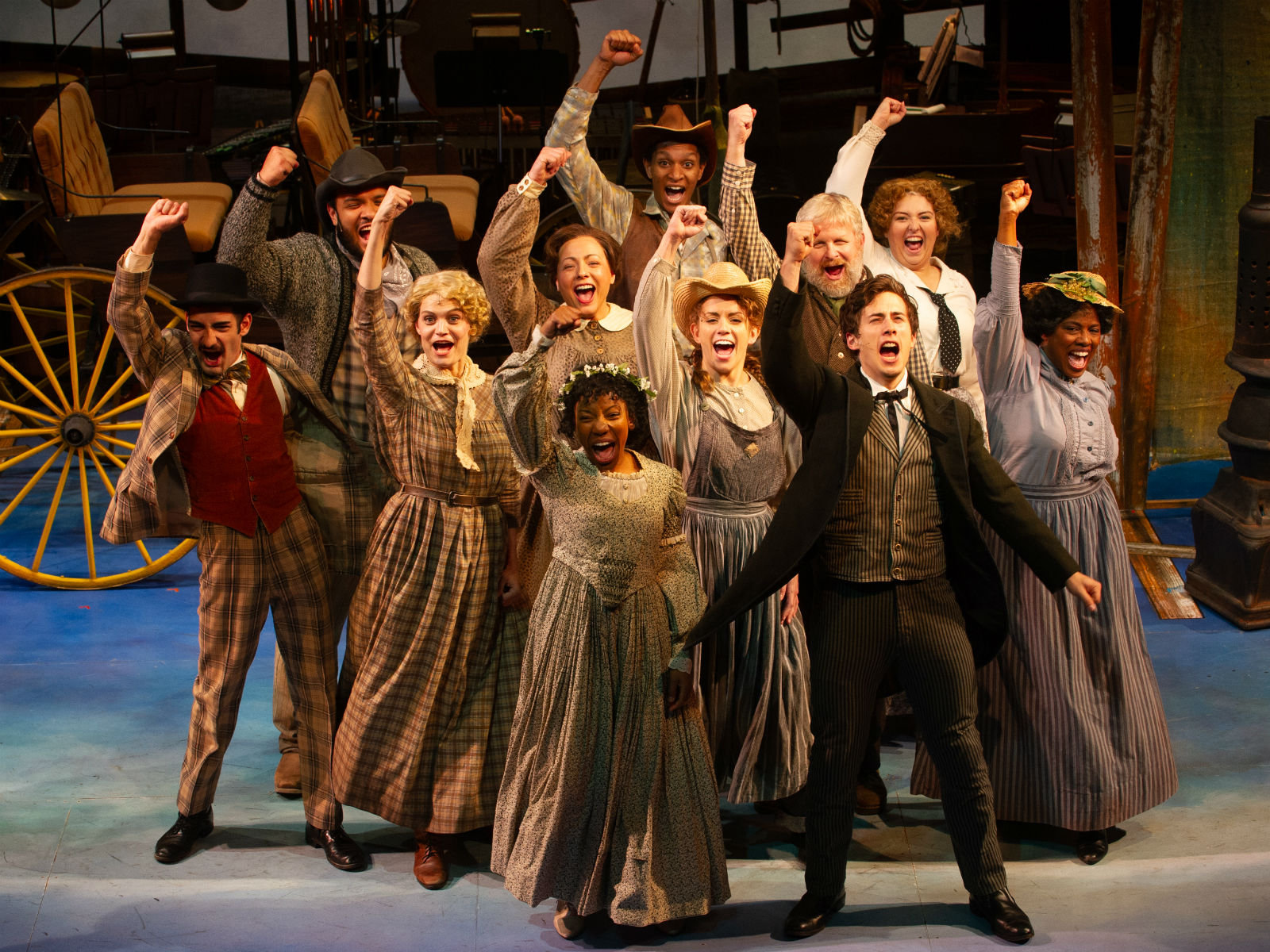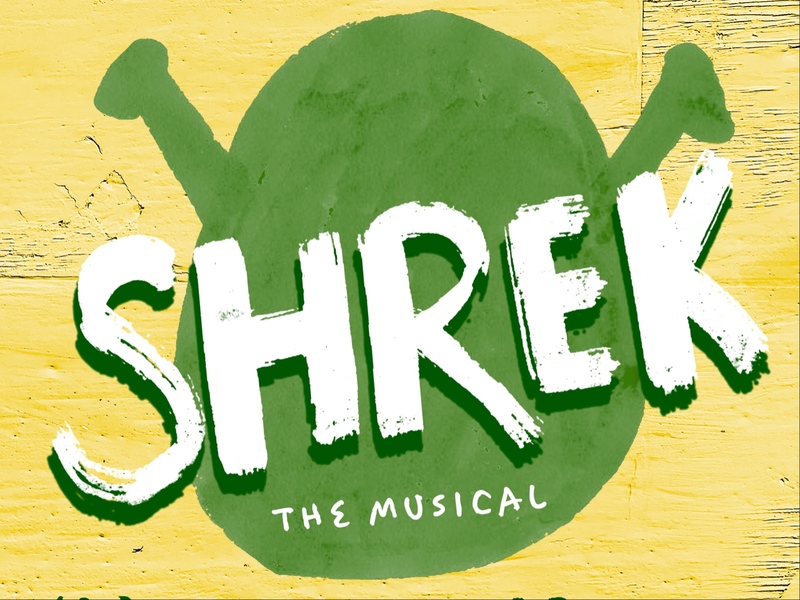It really is "a beautiful morning" for Curly, the aw-shucks, good as gold, crooning cowboy hero in Skylight Music Theatre’s season-opening production of the Rodgers and Hammerstein’s classic "Oklahoma!," which runs through Oct. 13 in the Cabot Theatre. With a smaller cast and a less opulent look at frontier life, it’s a gorgeously sung, faithful production of a 76-year old musical chestnut that fans of the classic will enjoy – though others may not celebrate the dated material with as many "yippee yay ayes."
As Curly, Lucas Pastrana proves once again that he is prime leading man material for musical theater. Played with straight-up earnestness and a delightful baritone that could fill the wide open fields of the Oklahoma territory, he looks perfectly at home in his fringed leather chaps and cowboy hat. (Previously he’s been a stand-out in Skylight’s "Pippin," "Sweeney Todd" and "Urinetown.")
His Curly isn’t a genius, but he knows what he’s good at: herding cattle. And he knows what he wants: the charming and lithe Laurey Williams (a delicate and fresh-faced Brittani Moore). Thus begins the story of several courtships – well matched and not – in a small Oklahoma town in 1906 on the edge of the Wild West.
Curly and Laurey seem like an obvious pair, both to good natured Aunt Eller (a salt-of-the-earth, pragmatic Cynthia Cobb) and to the audience. But Laurey doesn’t want to be obvious; she wants to be deliberate. And though such a small community doesn’t offer her many choices, she’s determined not to give her heart away to the only interested party. Or maybe she’s playing hard to get. Either way, she refuses Curly’s tuneful invitation to ride "in a surrey with the fringe on top" to the box social, choosing instead to go with the rough-around-the-edges and generally creepy hired hand Jud (an appropriately menacing Jeremy Peter Johnson).
And as a "serves you right, maybe you should have asked me sooner" move, it’s understandable. But Laurey’s confusion on the "Curly versus Jud" question seems bizarre as the play goes on. Sure, he’s humanized a bit in his beautifully sung "Lonely Room," but Laurey describes him as a stalker, says she’s uncomfortable in his presence, and it becomes very clear he’s a potentially violent guy with an inferiority complex and a feeling of entitlement.
Then again, when Curly shows up in Jud’s smokehouse residence to scare the guy off from pursuing his love, our hero tries to push him toward committing suicide. And well, that kind of manipulative bully isn’t ideal husband material either.
Our second potential couple, a foil for the squeaky clean cowboy and his little woman, is the walking-on-the-wild-side Ado Annie (a brassy Hannah Esch) and her goofy beau Will (the lanky Sean Anthony Jackson), whose skill with a lasso compensates for his poor mathematical abilities. Both wide-eyed and naive, they are each amazed about the possibilities presented by big cities and big displays of physical affection.
Will is so baffled by his good fortune – winning $50 in prize money from a rodeo contest – that he wants to keep AND spend the whole wad of cash. Similarly, Annie loves being kissed by Will AND romanced by the Persian peddler Ali Hakim (a pitch perfect Ethan D. Brittingham) even if the men’s motives are miles apart.
Sure, the characters were created just for laughs, and the good upstanding citizen in all of us is relieved that ultimately Ado Annie agrees to marry Will instead of being deflowered at a nearby hotel by the slick traveling salesman. But even in good fun, it’s cringeworthy when, at the end of the show, the pair comes onstage looking disheveled, and a euphoric Annie states that she and Will had a disagreement but then he "explained it to her," presumably with some hanky panky in the cornfields. That is one way to put a woman in her place.
Dressed in well-worn work clothes and prairie dresses, the palette of the costumes is muted – faded pinks, golds, browns and blues – as if they were drained of their color by too many washings or a permanent coat of plains dust. (Lovely, unified costume design by Karin Simonson Kopishke.)
Adding to the aesthetic of rough-hewn homesteads carved out of the land, the set’s proscenium is edged with a primitive wooden house frame that doubles as the trunks of green and tan fabric "trees." Combined with an ever changing, expansive sky, projected on a scrim along the back wall, Peter Dean Beck’s scenic design is a welcome departure from the more idyllic farmhouse and porch that is often used.
As she has done in previous productions, director Jill Anna Ponasik places the musicians on stage – including a piano, violin, bass and an enormous menagerie of percussion instruments for Michael "Ding" Lorenz to play with, even pots and pans, a washtub and a washboard. Among the instruments, there are set pieces such as baskets, barrels, lanterns, a wagon wheel, an embroidery sampler, a lasso and a wood-burning stove.
This makes it easy for the actors to bring on bits and pieces to suggest specific scenes, but it also fills up the stage with an old-time museum full of bric-a-brac. In a show that talks a lot about wide open spaces, the overall effect is claustrophobic.
Another Ponasik signature element is including some graceful modern dance interludes featuring Milwaukee Opera favorite Christal Wagner. And while her spins, leaps and ribbon dances are lovely, they feel out of step with the rest of the choreography by James Zager, which isn’t fancy. The cast does the two-step and traditional square dances with energy and ease.
Here, Laurey’s "dream ballet" is much more of a wordless drama than a dance sequence, which also feels right. It is consistent with the simpler, more straightforward approach of the production overall, and does a terrific job dramatizing the confusion and anxiety in Laurey’s mind.
And there is a lot to be anxious about in Oklahoma in 1906. Modern innovations on display in Kansas City include cars, multi-story buildings and freely available illicit sex in the form of burlesque houses, prostitutes and novelty porn. And even if you don’t travel to the big city, one can purchase nude pictures of French women from the traveling "gypsy" Ali, whose sells exotic trinkets to the hayseeds and then tries to seduce their women.
Oklahoma is also on the cusp of transforming from a free-for-all territory to a law-abiding state. Due to several land rushes in the late 19th century, the counties are filling up with farmers whose fences are encroaching on the cattle ranchers’ way of life, documented in the song "The Farmer and the Cowman." What the song doesn’t mention is that the sudden availability of land was precipitated by moving indigenous people to small reservations, further west.
Other racial tensions arose with the arrival of large numbers of black settlers. After droughts, crop failures and the depression of the 1890s, Oklahomans were desperate for the success they were promised after homesteading.
So the turn of the century, as well as the 1940s, when the musical debuted on Broadway, are perfect moments to place a narrative about the inevitable success of the white American male – a rugged individualist who can tame the land, triumph over any foe and create a well-ordered society where he will benefit.
In a recent interview, director Jill Anna Ponasik remarked that many patrons she spoke to were excited to see "Oklahoma" due to feelings of nostalgia. It’s true that the musical has been a staple for high schools, summer stock and dinner theaters for generations, and many musical theater lovers have fond memories of their own turns onstage as an Oklahoman rancher.
But the show really centers on nostalgia of a different kind. Its core story is a celebration of manifest destiny, where guns are used to settle differences, powerless women are literally bought and sold, and the good guy gets away with murder.







